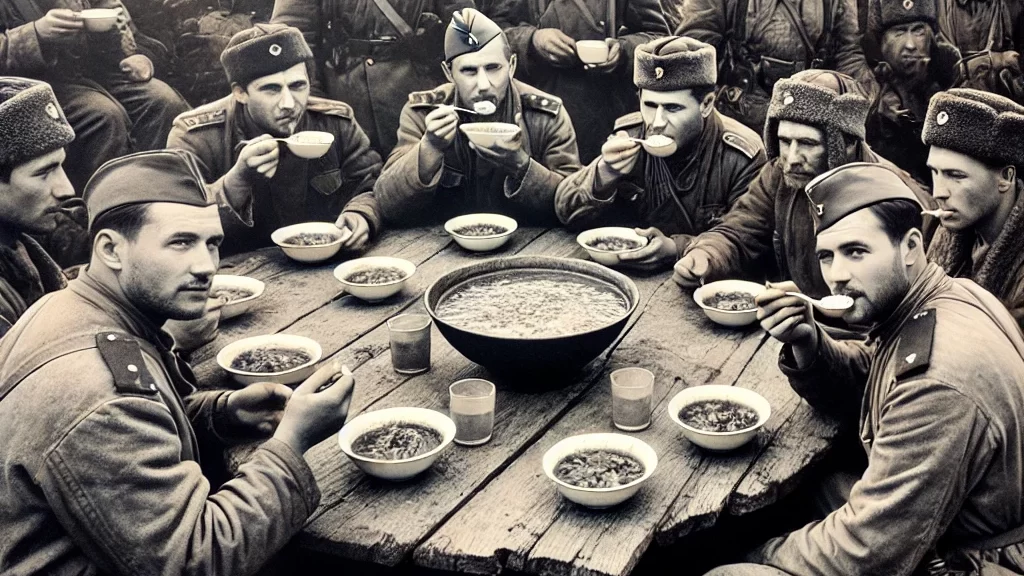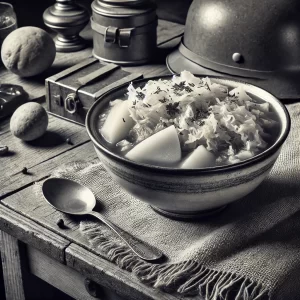Russian cuisine is known for its hearty and comforting dishes, and Shchi soup is no exception. This traditional cabbage soup has been a staple in Russian households for centuries. In this post, we’ll explore the history of Shchi soup, its connection to the Battle of Stalingrad, and provide a detailed recipe so you can enjoy this historical dish.
A Brief History of Shchi Soup
Shchi is a traditional Russian soup made primarily from cabbage. It dates back to the 9th century when cabbage was first introduced to Russia. Over the centuries, Shchi has become a beloved dish, often associated with Russian culture and heritage. The soup is known for its versatility, as it can be made with a variety of ingredients, including meat, mushrooms, and various vegetables.
The Battle of Stalingrad

The Battle of Stalingrad, one of the most significant battles of World War II, took place between August 23, 1942, and February 2, 1943. This brutal battle marked a turning point in the war, as the Soviet Union successfully defended the city of Stalingrad (now Volgograd) against the invading German forces.
The battle was characterized by intense urban warfare and significant casualties on both sides. The Soviet victory at Stalingrad was a major turning point in the war, leading to the eventual defeat of Nazi Germany.
The Role of Shchi Soup During the Battle

A Source of Sustenance and Morale
During the harsh winter months of the battle, Russian soldiers relied on hearty and nourishing foods like Shchi to sustain them. The simple yet robust ingredients of Shchi—cabbage, potatoes, and meat—provided essential nutrients and warmth in the freezing conditions. The soup was not only a source of sustenance but also a morale booster for the soldiers, reminding them of home and providing comfort amid the harsh realities of war.
Adaptability in Scarce Conditions
In the besieged city, food supplies were scarce, and the soldiers had to make do with what was available. Shchi, with its adaptable recipe, allowed for various substitutions based on what ingredients were on hand.
The ability to prepare a filling meal from limited resources made Shchi an invaluable dish for the troops. The communal aspect of preparing and eating Shchi also helped foster a sense of camaraderie among the soldiers, strengthening their resolve to defend their homeland.
Symbol of Resilience
The resilience and ingenuity of the Russian soldiers in making the most of their limited food supplies were exemplified in dishes like Shchi. This traditional soup, deeply rooted in Russian culture, became a symbol of endurance and perseverance during one of the most grueling battles of the war.
The warmth and nutrition provided by Shchi played a crucial role in sustaining the Soviet troops throughout the long and arduous winter of the Battle of Stalingrad.

Stalingrad Shchi Soup
Ingredients
- 1 small head of cabbage shredded
- 1 pound beef or pork cut into chunks
- 1 large onion chopped
- 2 carrots peeled and chopped
- 2 potatoes peeled and diced
- 2 cloves garlic minced
- 1 bay leaf
- 4 cups beef or vegetable broth
- 2 tablespoons tomato paste
- 1 tablespoon vinegar
- 2 tablespoons vegetable oil
- Salt and pepper to taste
- Fresh dill or parsley for garnish
- Sour cream for serving
Instructions
Prepare the Meat:
- In a large pot, heat the vegetable oil over medium heat. Add the meat and cook until browned on all sides. Remove the meat from the pot and set aside.
Cook the Vegetables:
- In the same pot, add the chopped onion, carrots, and garlic. Cook until the vegetables are softened, about 5 minutes.
Add the Cabbage and Potatoes:
- Add the shredded cabbage and diced potatoes to the pot. Stir well to combine with the other vegetables.
Simmer the Soup:
- Return the browned meat to the pot. Add the beef or vegetable broth, bay leaf, tomato paste, and vinegar. Bring the mixture to a boil, then reduce the heat and let it simmer for about 1 hour, or until the meat is tender and the flavors are well combined. Season with salt and pepper to taste.
Serve:
- Ladle the hot soup into bowls and garnish with fresh dill or parsley. Serve with a dollop of sour cream on top.